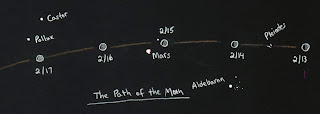Mornings during the seven days or so offer the skywatcher a chance to glimpse our solar system's two inner planets, Mercury and Venus. Their angular separation from the sun isn't great so they rise shortly before sunrise. Try looking very low in the east at 6:20 a.m. for bright Venus with dimmer Mercury above it. On March 5, the thin crescent moon joins them, but all three may be lost in the brightening twilight.
Such is our view from Earth...
Thursday, February 28, 2008
Wednesday, February 20, 2008
Eclipse and clouds
Unfortunately, the weather in southwest Virginia includes a generous amount of clouds during the total eclipse of the moon tonight. Therefore, the public observing near Explore Park session is cancelled. This certainly does not rule out people looking up on their own! Give it a try!
Even if it is cloudy, the backlit clouds resulting from the full moon, will be absent during totality. Between 10 and 11 pm, the clouds should be dark, except for any up-lighting from city lights below.
Such is our view from southwest Virginia...
Even if it is cloudy, the backlit clouds resulting from the full moon, will be absent during totality. Between 10 and 11 pm, the clouds should be dark, except for any up-lighting from city lights below.
Such is our view from southwest Virginia...
Public viewing of the eclipse
If the skies are clear tonight, the total eclipse is for all to see!
Partial phase begins — 8:43 p.m.
Total phase begins — 10:01
Total phase ends — 10:52
Partial phase ends — 12:09 a.m.
The Roanoke Valley Astronomical Society will hold a special observing session in honor of the Total Eclipse of the Moon.
When — Wednesday, February 20, 2008
Time — 8:30 p.m. to 11:30 p.m.
Where — First overlook on the Explore Park spur off the Blue Ridge Parkway
Telescopes will be focusing on the moon, Saturn, and other objects of interest.
The public is welcome! The event is free.
Of course, this public observing event occurs only if the skies are clear!
Such is our view from Earth...
Partial phase begins — 8:43 p.m.
Total phase begins — 10:01
Total phase ends — 10:52
Partial phase ends — 12:09 a.m.
The Roanoke Valley Astronomical Society will hold a special observing session in honor of the Total Eclipse of the Moon.
When — Wednesday, February 20, 2008
Time — 8:30 p.m. to 11:30 p.m.
Where — First overlook on the Explore Park spur off the Blue Ridge Parkway
Telescopes will be focusing on the moon, Saturn, and other objects of interest.
The public is welcome! The event is free.
Of course, this public observing event occurs only if the skies are clear!
Such is our view from Earth...
Tuesday, February 19, 2008
Enjoy the total eclipse of the moon!

On Wednesday evening the bright full moon moves into the Earth's shadow becoming completely eclipsed. The show begins at 8:43 p.m. EST as the moon slides into darkness. By 10:01 it moves entirely into our planet's shadow and the stars come out. To the moon's lower left is the ringed planet, Saturn while above it shines Regulus, the brightest star in the constellation Leo.
How dark will the moon appear? What color will it appear? Usually, it is not so dark that it can't be seen and its color is a dark coppery red. But none of this is definite!
Use binoculars to view a dim star near the moon's lower left edge. As the minutes pass, the moon moves closer to it, finally occulting it at 10:27. The star pops out the other side at about 11:17. By then totality is long over and the star may be difficult to spot in the increasing moonlight.
Totality ends at 10:52 p.m. A thin sliver of light spills from the dark disk's lower edge. Our sky grows brighter, quickly blotting out the dimmer stars. By 12:09 a.m. the partial phase ends as the moon moves completely out of the Earth's shadow. This is the same shadow that causes our "night." We happen to stand in the first few feet of our planet's shadow.
Such is our view from Earth...
Saturday, February 9, 2008
Moon passes the Pleiades and Mars

From 2/13 through 2/17, the moon passes several notable celestial objects. First, on the evening of February 13 the nearly first quarter moon sits to the west of the Pleiades star cluster. The following night, it jumps east of the Pleiades. On the 15th, the glaring orb is next to bright Mars. By February 17 the moon is in a fat gibbous shape shining to the lower right of the stars Pollux and Castor in the constellation Gemini. Why not follow it on its journey across the celestial dome?
Such is our view from Earth...
Tuesday, February 5, 2008
The moon joins Venus and Jupiter

Over the past week, Venus dropped past Jupiter. On Monday morning, our moon joined them in the early morning sky. As the days and weeks pass, Venus continues its decent, soon becoming lost in the solar glare. Jupiter, on the other hand, slowly becomes brighter as it rises earlier. By dawn it is well up in the southeast.
The image above was taken on February 4 at 6:35 a.m.
Such is our view from Earth...
Sunday, February 3, 2008
Venus passes Jupiter, part 5

What turned into an ice storm moved into southwest Virginia early Friday morning. The result for skywatchers was that the close approach of the two brightest planets was completely and utterly obscured by clouds. No conjunction for us! However, Saturday morning's scene was very pretty.
The shot above was taken at 6:35 a.m. Saturday, February 2. Venus is on the left.
Such is our view from Earth...
Subscribe to:
Comments (Atom)